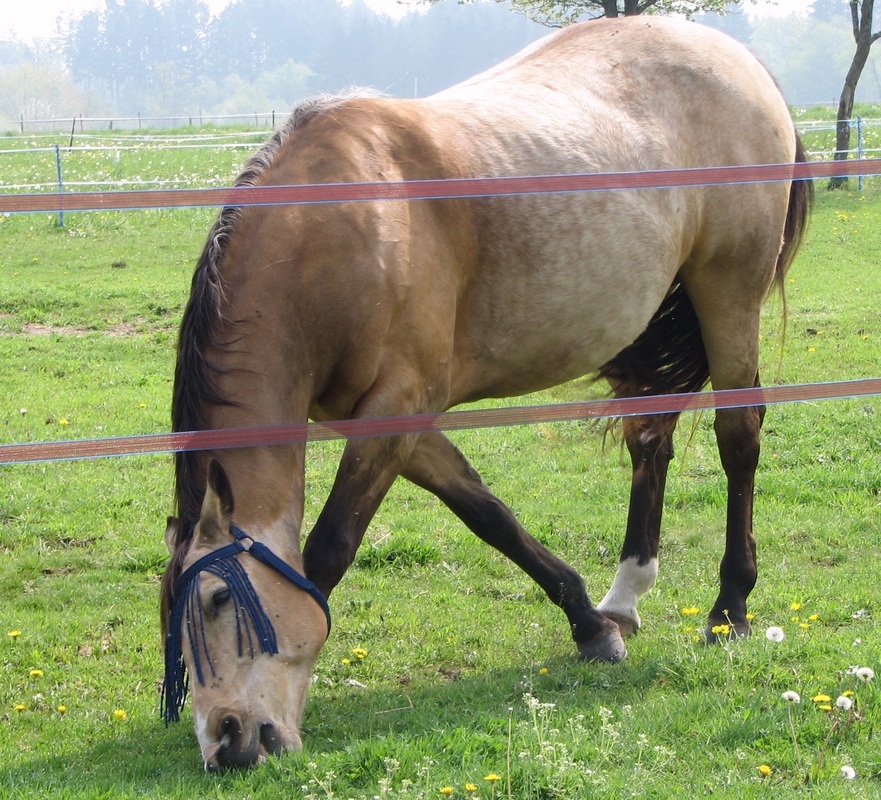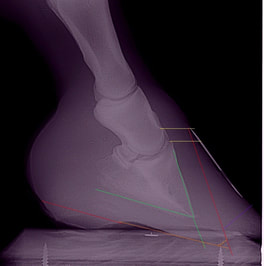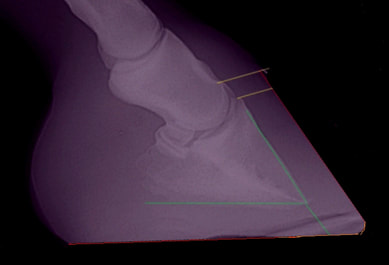Most horses with laminitis (particularly hyperinsulinaemia-associated laminitis) should make a good recovery when you act quickly to:
Identify and remove/treat/manage the cause, and
Support and realign the feet.
Many cases of laminitis can be prevented by recognizing the risk factors, e.g. insulin dysregulation (ID), Equine Metabolic Syndrome (EMS), PPID, and taking appropriate action.
If your horse has Laminitis, EMS or PPID - start here
1. Is it laminitis?
It's not always simple to diagnose laminitis.
Acute laminitis may be mistaken for colic or tying up.
Symptoms of chronic laminitis e.g. hoof rings and stretched or deep/disconnected white line may be missed, lameness due to laminitis may be misdiagnosed as hock lameness, bruised sole, abscess.
Generally if in doubt, assume laminitis until proven otherwise.
See Laminitis and Chronic Laminitis for a full list of symptoms.
Acute laminitis may be mistaken for colic or tying up.
Symptoms of chronic laminitis e.g. hoof rings and stretched or deep/disconnected white line may be missed, lameness due to laminitis may be misdiagnosed as hock lameness, bruised sole, abscess.
Generally if in doubt, assume laminitis until proven otherwise.
See Laminitis and Chronic Laminitis for a full list of symptoms.
2. Identify and remove/treat the cause
Once you know your horse has got laminitis, ask WHY has it got laminitis - there is always a cause, which must be identified/diagnosed to guide treatment/management.
Most laminitis is due to insulin dysregulation (ID) - this form of laminitis is now called hyperinsulinaemia-associated laminitis, or HAL (previously referred to as endocrinopathic laminitis, or pasture associated laminitis). Horses with insulin dysregulation usually have Equine Metabolic Syndrome (EMS), and may have PPID (formerly called Cushing's disease) if aged 10+. Corticosteroid treatment has been shown to increase insulin dysregulation and may increase the risk of hyperinsulinaemia-associated laminitis.
Other causes of laminitis are Sepsis Related Laminitis (SRL) (or very sick horse laminitis - e.g. following retained placenta, colitis, colic) and Supporting Limb Laminitis (SLL) (or very lame horse laminitis).
Most laminitis is due to insulin dysregulation (ID) - this form of laminitis is now called hyperinsulinaemia-associated laminitis, or HAL (previously referred to as endocrinopathic laminitis, or pasture associated laminitis). Horses with insulin dysregulation usually have Equine Metabolic Syndrome (EMS), and may have PPID (formerly called Cushing's disease) if aged 10+. Corticosteroid treatment has been shown to increase insulin dysregulation and may increase the risk of hyperinsulinaemia-associated laminitis.
Other causes of laminitis are Sepsis Related Laminitis (SRL) (or very sick horse laminitis - e.g. following retained placenta, colitis, colic) and Supporting Limb Laminitis (SLL) (or very lame horse laminitis).
3. Support and realign the feet
Support your horse's feet immediately to minimise damage, restrict movement and encourage him/her to lie down. Have digital radiographs (x-rays) taken, and get the feet trimmed to correct/realign rotation/distal descent as soon as possible to prevent further damage.
Failure to realign the hoof to P3 quickly can cause circulation compromise leading to infection, bone loss and eventually euthanasia.
Failure to realign the hoof to P3 quickly can cause circulation compromise leading to infection, bone loss and eventually euthanasia.
Daily checks that can help early identification of laminitis:
- Walk on hard ground e.g. concrete - does the stride shorten?
- Turn in a tight circle
- Digital pulses - normal?
- Regional fat pads - cresty neck, bulges in hollows above eyes, enlarged sheath, fat above tail?
For more information about the types of laminitis, symptoms, emergency treatment and longer-term management, see Laminitis
For a quick introduction to laminitis, Insulin Resistance/EMS & Cushing's/PPID, have a look at our slide show.
Download our Laminitis, EMS and PPID pdf sheet
For a quick introduction to laminitis, Insulin Resistance/EMS & Cushing's/PPID, have a look at our slide show.
Download our Laminitis, EMS and PPID pdf sheet
Need help or support or want to know more about laminitis, EMS and PPID?
a. Become a Friend of The Laminitis Site and access the FoTLS Facebook support group, where you can post questions, discuss articles and research, and set up a case history for your horse with x-rays, photos and blood test results so that relevant information can be suggested. There is a minimum annual donation of £12 for membership of FoTLS.
b. Many questions will be answered in the A-Z, from α-MSH to Weight loss, via Bute, Dexamethasone, Digital Pulse, Glucose, Hay soaking, Leptin, Metformin, Muzzles, NSAIDs, Obesity, Pergolide, Sheath swelling, Thyroid, Vitex Agnus Castus, and many more topics - available to Friends of The Laminitis Site only.
c. Read the latest and most important research papers on laminitis, IR and PPID listed by author and year in the Research pages.
d. Keep up to date with new developments and research, important information for the time of year, forthcoming webinars and conferences, and more on The Laminitis Site's Facebook page.
a. Become a Friend of The Laminitis Site and access the FoTLS Facebook support group, where you can post questions, discuss articles and research, and set up a case history for your horse with x-rays, photos and blood test results so that relevant information can be suggested. There is a minimum annual donation of £12 for membership of FoTLS.
b. Many questions will be answered in the A-Z, from α-MSH to Weight loss, via Bute, Dexamethasone, Digital Pulse, Glucose, Hay soaking, Leptin, Metformin, Muzzles, NSAIDs, Obesity, Pergolide, Sheath swelling, Thyroid, Vitex Agnus Castus, and many more topics - available to Friends of The Laminitis Site only.
c. Read the latest and most important research papers on laminitis, IR and PPID listed by author and year in the Research pages.
d. Keep up to date with new developments and research, important information for the time of year, forthcoming webinars and conferences, and more on The Laminitis Site's Facebook page.
|
If you are looking for help because your horse has laminitis, EMS or PPID)
|
|
To support our rehabilitation & rescue work and to keep this website alive
|



